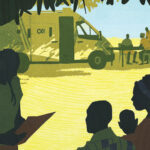
Move over, Triceratops—there’s a new horned dino in town. The Lokiceratops rangiformis, meaning “Loki’s horned face that looks like a caribou,” was recently excavated from the badlands of northern Montana, and a cast skull is now on display at the Natural History Museum of Utah (NHMU) at the University of Utah.
This behemoth, which roamed the earth 78 million years ago, boasts the largest frill horns ever found on a horned dinosaur. Its distinctive features include two huge, blade-like horns on the back of its frill and a unique asymmetric spike in the middle, reminiscent of the antlers of modern-day caribou.
“This new dinosaur pushes the envelope on bizarre ceratopsian headgear,” says Joseph Sertich MS’06, co-leader of the study. “These skull ornaments are one of the keys to unlocking horned dinosaur diversity.”
The discovery of Lokiceratops is particularly significant as it’s the fourth centrosaurine, and fifth horned dinosaur overall, identified from a single assemblage. This unprecedented concentration of species in a small geographic area challenges assumptions about dinosaur diversity.
“Previously, paleontologists thought a maximum of two species of horned dinosaurs could coexist at the same place and time. Incredibly, we have identified five living together at the same time,” explains Mark Loewen PhD’09, U professor of geology and geophysics and researcher at NHMU. Loewen was co-lead author of the study.
This high prevalence suggests that dinosaur diversity may be vastly underestimated. Scientists now believe that rapid evolution, possibly driven by sexual selection, led to a turnover of individual species every 100,000 to 200,000 years.
The individual fossilized skull bones of Lokiceratops were integrated into a state-of-the-art reconstruction of the complete skull, which is permanently reposited and displayed at the Museum of Evolution in Maribo, Denmark, alongside a collection of other scientifically significant dinosaurs.



Very exciting! I taught dinosaurs to second graders back the ‘80’s in Wyoming.we made fossils, learned about a select Few. Wonderful experience though art, making albums, drawings, by copying my beautiful collection from England, Professor at WWCC raised $$ for life sized metal sculptures! Great exhibition!